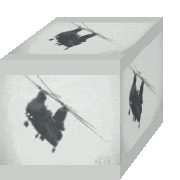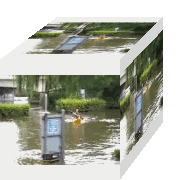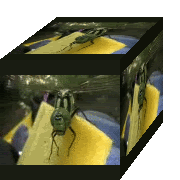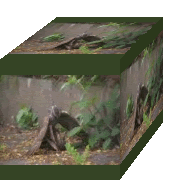 In fact they can see well into the infra red band of the spectrum, and this is where the fun begins. In order for the camera to pick up the infra red you have to filter out the rest of the visible spectrum. You can buy infra red pass filters but they're rather expensive. Here is a cheaper way...
In fact they can see well into the infra red band of the spectrum, and this is where the fun begins. In order for the camera to pick up the infra red you have to filter out the rest of the visible spectrum. You can buy infra red pass filters but they're rather expensive. Here is a cheaper way... First see if your camera can see infra red. To do this, switch it on and point a TV remote at the lens, press and hold one of the remote buttons. You won't be able to see the light, but if your camera can then your half way there. Next, sort out your old photos, or more exactly the negatives, remember those, before all this electrickery gadgetry digital malarky? Now, what you're looking for is the bits at the end of the negatives, the spare bit that has no image on it but has been exposed and developed. It should appear dark reddy brown. Transparent bits are no good.
First see if your camera can see infra red. To do this, switch it on and point a TV remote at the lens, press and hold one of the remote buttons. You won't be able to see the light, but if your camera can then your half way there. Next, sort out your old photos, or more exactly the negatives, remember those, before all this electrickery gadgetry digital malarky? Now, what you're looking for is the bits at the end of the negatives, the spare bit that has no image on it but has been exposed and developed. It should appear dark reddy brown. Transparent bits are no good. You need enough of this stuff to cover the lens, and you need three to four layers. Clip them together or tape them at the edges and then attach them to the lens in such a way that no light can get in around the edges (you'll have to figure this bit out by yourself).
You need enough of this stuff to cover the lens, and you need three to four layers. Clip them together or tape them at the edges and then attach them to the lens in such a way that no light can get in around the edges (you'll have to figure this bit out by yourself). I used a camcorder for these photos, which are better suited for this because they are biased towards being able to film in low light etc, while digital stills cameras specialise in good depth of colour and so often filter infra red out in order to maintain a correct colour balance. To combat this, either take your camera apart and remove the cyan correction filter (only do this if you have an old camera that you don't mind ruining, as inevitably you are left with a matchbox full of spare bits that no longer want to go back....all modern cameras are assembled by minute elves, this is the only way to make them so small), or set to 'low light' / 'night shot' etc.
I used a camcorder for these photos, which are better suited for this because they are biased towards being able to film in low light etc, while digital stills cameras specialise in good depth of colour and so often filter infra red out in order to maintain a correct colour balance. To combat this, either take your camera apart and remove the cyan correction filter (only do this if you have an old camera that you don't mind ruining, as inevitably you are left with a matchbox full of spare bits that no longer want to go back....all modern cameras are assembled by minute elves, this is the only way to make them so small), or set to 'low light' / 'night shot' etc. Best results are achieved on a bright sunny day. It won't work when it's dull, cos there's barely enough light for the camera to operate with. You may need to manually adjust the focus as well.
Best results are achieved on a bright sunny day. It won't work when it's dull, cos there's barely enough light for the camera to operate with. You may need to manually adjust the focus as well. If anyone has any success with this I would love to see you post the results.
If anyone has any success with this I would love to see you post the results. Many insects and particularly bees can detect infra red, this is why they are sometimes attracted to what at first glance seems like a rather plain flower, but under infra red often display patterns you wouldn't know were there.
Many insects and particularly bees can detect infra red, this is why they are sometimes attracted to what at first glance seems like a rather plain flower, but under infra red often display patterns you wouldn't know were there. Open water shows up inky black. Use a polarising filter (if your camera can cope with even less light!) and you will be able to cut the reflection and film fish which shine brightly!
Open water shows up inky black. Use a polarising filter (if your camera can cope with even less light!) and you will be able to cut the reflection and film fish which shine brightly!Some car windows have special layers on them to block sunlight and they show up opaque black.
 Finally, a warning... Humans reflect infra red and so show up light. Some types of clothes don't reflect infra red so appear invisible. In some circumstances your camera will work like X-ray specs!!! Might seem to good to be true, but BEWARE..When Great Aunt Flo comes to visit wearing her new light summer dress you could see a sight that no mere mortal was meant to see........my eyes!!!
Finally, a warning... Humans reflect infra red and so show up light. Some types of clothes don't reflect infra red so appear invisible. In some circumstances your camera will work like X-ray specs!!! Might seem to good to be true, but BEWARE..When Great Aunt Flo comes to visit wearing her new light summer dress you could see a sight that no mere mortal was meant to see........my eyes!!!
 Finally, a warning... Humans reflect infra red and so show up light. Some types of clothes don't reflect infra red so appear invisible. In some circumstances your camera will work like X-ray specs!!! Might seem to good to be true, but BEWARE..When Great Aunt Flo comes to visit wearing her new light summer dress you could see a sight that no mere mortal was meant to see........my eyes!!!
Finally, a warning... Humans reflect infra red and so show up light. Some types of clothes don't reflect infra red so appear invisible. In some circumstances your camera will work like X-ray specs!!! Might seem to good to be true, but BEWARE..When Great Aunt Flo comes to visit wearing her new light summer dress you could see a sight that no mere mortal was meant to see........my eyes!!!





13 comments:
Way Cool stuff Barkfoot! Onya for experimenting!
Very cool! I will give that a try!
VERY interesting! I want to see the photo of your Great Aunt Flo ;)
It is fantastic how the spectrum can change the entire perspective of the world!
I loved these photos Barky!
xo
Blue
incredible shots
and you are the first guy I've ever heard mention AF.
are you a photographer by trade???
Thanks for this! I am going to be trying it...very interesting! :-)
I love the picture of your lawn, it looks like one of those perfect frosty mornings where all the grass turns white, but even better.
I had a friend in HS who had used infred film.I loved the look of wintery dreamy scenes. I will definitely try this out. Thank you for sharing.
These are awesome!
I love these!
Awesome work Barky. My simple camera won't do any of these things but it is fascinating.
Thsnk you for all the information on Cattails. I had no idea it was such a resource.
You might find that your camera, Sony Cyber shot I think you said, is actually too good. It is probably comprehensively filtering out infra red in order to give good daylight colour balance. You could try something older/ less sophisticated or even a black and white security camera (look for lines of LEDs down either side of the lens and cover the daylight sensor with tape).
How very cool! I used to shoot with infra red a lot when I was younger. I'd shoot, then print on fiber based paper and apply Marshall's Photo Oils in order to completely transform a scene to the magical one in my dreams.
These make me want to try it again. Of course, seeing as I have a Canon EOS digital, I'll most likely go the expensive filter route...
Very creative and inspiring Barkfoot!
Whoa! How did I forget this????
Im off to find that old box of film photos, theres got to be some film negs in there somewhere - thanks for the tip off Mate!!!!
Post a Comment